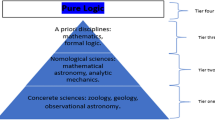Abstract
There are several important criticisms against the unificationist model of scientific explanation: (1) Unification is a broad and heterogeneous notion and it is hard to see how a model of explanation based exclusively on unification can make a distinction between genuine explanatory unification from cases of ordering or classification. (2) Unification alone cannot solve the asymmetry and irrelevance problems. (3) Unification and explanation pull in different directions and should be decoupled, because for good scientific explanation extra ad explanandum information is often required. I am presenting a possible solution to those problems, by focusing on an often overlooked but important element of how theoretic unification is achieved—the conceptual frameworks of theories. The core conceptual assumptions behind theories are decisive for discriminating between explanatory and non-explanatory unification. The conceptual framework is also flexible enough to balance the tension between informativeness and maximum systematization in constructing explanatory inferences. A short case study of orthogenetic and Darwinian explanations in paleontology is presented as an illustration of how my addition to the unificationist model is applicable to a historical debate between rival explanations.

Similar content being viewed by others
Notes
Adapted from Bouchard and Rosenberg (2004).
The scope of invariance and stability in this sense is defined not by realistically possible interventions or experiments which are limited in range, but by a form of counterfactual. This, however, is not so straightforward. To measure the scope of invariance and stability in this way requires some form of quantifying or counting the interventions. Here, however, we are interested in conceptually possible interventions, not on actual experimental ones. But this creates an infinity of similar interventions with every addition of intermediate steps between “firing a gun ? person’s death” because the possible worlds in which the interventions are carried out are defined within a logical space characterized by “an abundance” of possible worlds. To quote Lewis (1986, p. 86):
(1) absolutely every way that a world could possibly is a way that some world is and
(2) absolutely every way that a part of a world could possibly be is a way that some part of some world is.
References
Barnes, E. (1992). Explanatory unification and the problem of asymmetry. Philosophy of Science, 59, 558–571.
Bartelborth, T. (2002). Explanatory unification. Synthese, 130, 91–107.
Binet, A., & Féré, C. (1888) Animal magnetism. New York: Appleton and Co. Accessed November 19, 2014 from www.academia.dk/MedHist/Biblioteket/mesmer_propositions.php.
Bouchard, F., & Rosenberg, A. (2004). Fitness, probability, and the principles of natural selection. British Journal of the Philosophy of Science, 55, 693–712.
Bowler Peter, J. (1989). Evolution: The history of an Idea (Revised ed., pp. 268–270). Berkely: University of California Press.
Brandon, R. N. (1978). Adaptation and evolutionary theory. Studies in History and Philosophy of Science, 9, 181–206.
Dobzhansky, T. (1970). Genetics of the evolutionary process. New York: Columbia University Press.
Friedman, M. (1974). Explanation and scientific understanding. Journal of Philosophy, 71, 5–19.
Gould, S. J. (1977). The misnamed, mistreated, and misunderstood Irish elk in Ever Since Darwin. New York: Norton.
Gould, S. J. (2002). The Structure of Evolutionary Theory (pp. 351–383). Cambridge, MA: The Belknap Press of Harvard University Press.
Goodwin, R. M. (1967). A growth cycle. In C. H. Feinstein (Ed.), Socialism, capitalism and economic growth (pp. 54–58). Cambridge: Cambridge University Press.
Halonen, I., & Hintikka, J. (1999). Unification - It’s Magnificent but is it Explanation? Synthese, 120, 27–47.
Hansson, B. (2007). Explanations are about concepts and concept formation. In J. Persson & P. Ylikoski (Eds.), Rethinking explanation (pp. 3–11). Dordrecht: Springer.
Kitcher, P. (1976). Explanation, Conjunction and Unification. Journal of Philosophy, 73, 207–212.
Kitcher, P. (1989). Explanatory unification and the causal structure of the world. In P. Kitcher & W. Salmon (Eds.), Scientific explanation (pp. 410–505). Minneapolis: University of Minnesota Press.
Lange, M. (2013). What makes a scientific explanation distinctively mathematical. British Journal of Philosophy of Science, 64, 485–511.
Lewis, D. (1986). On the plurality of worlds. Oxford: Basil Blackwell.
Lipton, P. (2004). What good is an explanation. In J. Cornwell (Ed.), Explanations. Styles of explanation in science (pp. 1–21). Oxford: Oxford University Press.
Malo, A. F., Roldan, E. R. S., Garde, J., Soler, A. J., & Gomendio, M. (2005). Antlers honestly advertise sperm production and quality. Proceedings of the Royal Society Biological Sciences Series B, 272, 149–157.
Morrison, M. (2000). Unifying scientific theories. Cambridge: Cambridge University Press.
Mills, S. K., & Beatty, J. H. (1979). The propensity interpretation of fitness. Philosophy of Science, 46, 263–286.
Porter, R. (1999). The greatest benefit to mankind: A medical history of humanity. London: Harper Collins Publishers.
Putnam, H. (1975). Philosophy and our mental life. In H. Putnam (Ed.), Mind, language and reality: Philosophical papers (pp. 295–297). Cambridge: Cambridge University Press.
Rasser, M. (2013). Darwin’s dilemma: The Steinheim snails’ point of view. Zoosystematics and Evolution, 89(1), 13–20.
Salmon, W. (1984). Scientific explanation and the causal structure of the world. Princeton: Princeton University Press.
Schurz, G. (1999). Explanation as unification. Synthese, 120, 94–114.
Sober, E. (1983). Equilibrium explanation. Philosophical Studies, 43, 201–10.
Van Fraassen, B. (1980). The scientific image. Oxford: Oxford University Press.
Weber, E., & Van Dyck, M. (2002). Unification and explanation. A comment on Halonen and Hintikka, and Schurz. Synthese, 131, 145–154.
Weisberg, M. (2007). Who is a modeler? British Journal for the Philosophy of Science, 58, 207–233.
Weisberg, M. (2013). Simulation and similarity. Oxford: Oxford University Press.
Woodward, J. (2003). Making things happen: A theory of causal explanation. Oxford: Oxford University Press.
Woodward, J. (2010). Causation in biology: stability, specificity, and the choice of levels of explanation. Biology & Philosophy, 25(3), 287–318.
Yip, S. P. (2002). Sequence variation at the human ABO locus. Annals of Human Genetics, 66(1), 1–27.
Author information
Authors and Affiliations
Corresponding author
Rights and permissions
About this article
Cite this article
Petkov, S. Explanatory unification and conceptualization. Synthese 192, 3695–3717 (2015). https://doi.org/10.1007/s11229-015-0716-2
Received:
Accepted:
Published:
Issue Date:
DOI: https://doi.org/10.1007/s11229-015-0716-2




